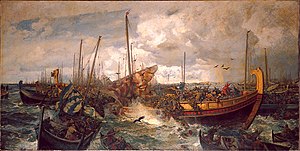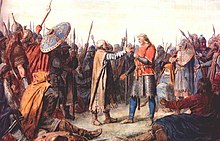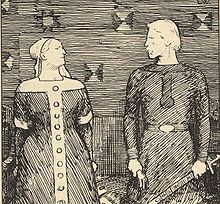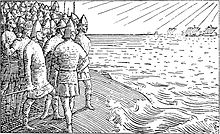Battle of Svolder
| Battle of Svolder | |||||||
|---|---|---|---|---|---|---|---|
 The Battle of Svolder, by Otto Sinding | |||||||
| |||||||
| Belligerents | |||||||
|
|
Jarls of Lade | ||||||
| Commanders and leaders | |||||||
|
Einar Tambarskjelve |
Svein Forkbeard | ||||||
| Strength | |||||||
| 11 warships | 70+ warships | ||||||
| Casualties and losses | |||||||
| Heavy, all ships captured | Reportedly heavy | ||||||
|
There are no detailed contemporary sources. Information such as the number of ships cannot be regarded as reliable history. | |||||||
The Battle of Svolder (Svold or Swold)
King
The exact location of the battle is disputed, and depends on which group of sources is preferred: Adam of Bremen places it in Øresund, while Icelandic sources place the battle near an island called Svolder, which is otherwise unknown.
The most detailed sources on the battle, the
In later centuries, the saga descriptions of the battle, especially that in Snorri Sturluson's Heimskringla, have inspired a number of ballads and other works of literature.
Context
In earliest recorded history,

In the 970s,
While rejecting Danish authority, Olaf made it his mission to convert Norway and the Norse colonies in the west as quickly and as completely as possible. Proceeding with threats, torture and executions, Olaf broke down pagan resistance and within a few years Norway was, at least nominally, a Christian country. But King Olaf had acquired several enemies during his meteoric rise to power. The most prominent were Eirik Jarl, son of Haakon Jarl, and
The same interests which clashed in the Battle of Svolder were to divide Norway for decades to come, leading to further major engagements, including the Battle of Nesjar and the Battle of Stiklestad. The resolution came in 1035 with the accession of the Norwegian Magnus the Good to the throne of an independent and Christian Norway.[7]
Sources

The Battle of Svolder is mentioned in a number of historical sources. The earliest written work is by
In Norway the three synoptic histories,
Contemporary
While historians value contemporary skaldic poetry highly as the most accurate source available, it must be remembered that the poems are not preserved independently but as quotations in the kings' sagas. After two centuries of oral preservation, there is often doubt that a verse was accurately remembered and correctly attributed. Furthermore, skaldic poetry did not primarily aim at giving information but at artistically rendering facts already known to the hearers.[10] Historians frequently fall back on the less reliable but more detailed accounts of the sagas.
Events leading up to the battle

Nothing can be gleaned from the contemporary skaldic poems on the causes of the battle. Adam of Bremen states that

Fagrskinna and Heimskringla largely follow Oddr's account but simplify it and diverge from it in some respects. According to Heimskringla, Sigvaldi sailed from Wendland with Olaf and a fleet of Wendish ships and led him into the ambush.
Whether the above details are accurate or not, it is clear that Svein, Olaf the Swede and Eirik had ample reason to oppose Olaf Tryggvason. Olaf had taken control of
From the conflicting accounts of the sources, historians have tried to reconstruct the most likely sequence of events leading up to the battle. It is probable that Olaf Tryggvason was indeed sailing from Wendland to Norway when he was ambushed, though the kings' sagas probably play up the importance of Thyri and her marriages. While it is possible that Olaf was collecting dowry, it seems more probable that he was expecting war and seeking allies in Wendland, but met with little success. The character of Sigvaldi remains enigmatic, though there is evidence from skaldic poetry that he did indeed betray Olaf.[18]
Time and location
All sources which date the battle agree that it took place in 1000. The oldest source to date it is the meticulous Íslendingabók, written around 1128, which specifies that it took place in the summer. Oddr Snorrason says further that the battle is "memorialized for the fallen men on the Third or Fourth Ides of September",[19] (10 or 11 September). Mesta states that the battle occurred on 9 September, and other sources agree with either date. Since some medieval writers reckoned the end of the year in September, it is possible that the year referred to is in fact the one we know as 999.[20]
The location of the battle cannot be identified with any certainty. According to Adam of Bremen, it took place in
Composition of the fleets
The Norse sources agree that Olaf Tryggvason fought against overwhelming odds in the battle. Fagrskinna, for example, says that he had "only a small force", and that the sea around him was "carpeted with warships"[27] The sources which specify the number of warships all agree that Olaf Tryggvason had 11 vessels but they give various numbers for the allied fleets. Most sources cite the Danish and Swedish forces as equal in size, with the exception of Rekstefja.
| Source | Olaf Tryggvason | Olaf the Swede | Eirik | Svein | Allied total | Ref. |
|---|---|---|---|---|---|---|
| Oddr Snorrason | 11 | 60 | 19 | 60 | 139 | [28] |
| Ágrip | 11 | 30 | 22 | 30 | 82 | [29] |
| Historia Norwegie | 11 | 30 | 11 | 30 | 71 | [30] |
| Theodoricus monachus | 11 | - | - | - | 70 | [31] |
| Rekstefja | 11 | 15 | 5 | 60 | 80 | [32] |
Though the sagas agree that Olaf Tryggvason had only 11 ships in the battle, some of them quote a verse by Halldórr the Unchristian saying that Olaf had 71 ships when he sailed from the south. The sagas explain the discrepancy by saying that some of the 71 ships belonged to Jarl Sigvaldi, who deserted Olaf, and that others sailed past the trap at Svolder before it was sprung.
Ships by name
The sagas describe three of the ships in Olaf Tryggvason's fleet. According to Heimskringla, the Crane was a large swift-sailing warship with thirty rowers' benches, high in stem and stern.[33] It was commissioned by King Olaf and used as his flagship for some time.
Olaf confiscated the second of his great ships from a pagan he had tortured to death for refusing to convert to Christianity. King Olaf "steered it himself, because it was a much larger and finer ship than the Crane. Its stem had a dragon's head on it, and on its stern, a crook shaped like a tail; and both sides of the neck and all the stern were gilded. That ship the king called the Serpent, because when the sail was hoisted it was to look like the wing of a dragon. That was the finest ship in all Norway."[34]
Olaf's third flagship, the
It was constructed as a dragon ship, on the model of the Serpent which the king had taken along from Hálogaland; only it was much larger and more carefully wrought in all respects. He called it the Long Serpent and the other one, the Short Serpent. The Long Serpent had thirty-four compartments. The head and the tail were all gilt. And the gunwales were as high as those on a seagoing ship. This was the best ship ever built in Norway, and the most costly.[35]
The only allied ship described is Jarl Eirik's iron clad Járnbarðinn,
Original Icelandic text: Eiríkr jarl hafði barða einn geysimikinn, er hann var vanr at hafa í víking;
þar var skegg á ofanverðu barðinu hváru tveggja;
en niðr frá járnspǫng þykk ok svá breið sem barðit ok tók alt í sjá ofan.
Open translation: "Earl Eirik owned a mighty great ship (referred to as a barda) which he was accustomed to take on his
The leaders assess their opponents
It is unlikely that the saga writers had accurate information on details of the battle beyond the sparse accounts in the surviving poems. Nevertheless, starting with Oddr Snorrason, they present an elaborate literary account, depicting the main participants through their words and deeds.
Olaf Tryggvason's ships pass the anchorage of his allied enemies in a long column without order, as no attack is expected.[41] Conveniently placed to observe the fleet, Jarl Eirik and the two kings remark upon the passing vessels. Svein and Olaf are eager to join battle, but Eirik is portrayed as more cautious and familiar with the Norwegian forces.

As progressively larger vessels appear, the Danes and Swedes think each one is the Long Serpent and want to attack straight away, but Eirik holds them off with informed comments:[42]
It is not King Olaf on this ship. I know this ship because I have seen it often. It is owned by
Jaðarr, and it is better to attack this ship from the stern. It is manned with such fellows that, should we encounter King Olaf Tryggvason, we will quickly learn that it would be better for us to find a gap in his fleet than to do battle with this longship.[43]
As Eirik finally consents to attack, King Svein boasts that he will command the Long Serpent "before the sun sets". Eirik makes a remark "so that few men heard him" saying that "with only the Danish army at his disposal, King Sveinn would never command this ship".[43] As the allies set out to attack Olaf Tryggvason, the point of view shifts to the Norwegian fleet.
After spotting the enemy, Olaf might have used sail and oar to outrun the ambush and escape, but he refuses to flee and turns to give battle with the eleven ships immediately about him. Seeing the Danish fleet arrayed against him, he comments: "The forest goats will not overcome us, for the Danes have the courage of goats. We will not fear that force because the Danes have never carried off the victory if they fought on ships."[44] Similarly, Olaf writes off the Swedes with a reference to their pagan customs:
The Swedes will have an easier and more pleasant time licking out their sacrificial bowls than boarding the Long Serpent in the face of our weapons and succeeding in clearing our ships. I expect that we will not need to fear the horse eaters.[45]
It is only when Olaf Tryggvason sights Eirik Hákonarson's contingent that he realises he is in for a hard battle, because "they are Norwegians like us".[46] The sagas' emphasis of Eirik's contribution stands in marked contrast to the Danish accounts of Adam of Bremen and Saxo Grammaticus, who portray the battle as a Danish victory over Norwegians, with no mention of Jarl Eirik or his men.
The battle is joined

The disposition adopted in the battle was one which recurs in many sea-fights of the Middle Ages where a fleet had to fight on the defensive.[47] Olaf lashed his ships side to side, with his own, the Long Serpent, in the middle of the line, where her bows projected beyond the others. The advantages of this arrangement were that it left all hands free to fight, that a barrier could be formed with the oars and yards, and that it limited the enemy's ability to make its superior numbers count. The Long Serpent was the longest ship and so also the tallest—another advantage to the defenders, who could rain down arrows, javelins and other missiles while the enemy would have to shoot upwards. Olaf, in effect, turned his eleven ships into a floating fort.[41]
The sagas give all the credit to the Norwegians, praising Eirik Hákonarson for any intelligence and for most of the valour shown by Olaf Tryggvason's opponents. The Danes and Swedes rush at the front of Olaf's line and are repulsed, suffering heavy casualties and loss of ships. Jarl Eirik attacks the flank and forces his vessel, the Járnbarðinn, up against the last ship of Olaf's line, which he clears with a fierce attack and then proceeds onto the next ship. In this way, Olaf's ships were cleared one by one, till the Long Serpent alone was left.[41]
Einarr Þambarskelfir
One of the best known episodes from the battle involves
Einar shot an arrow at Earl Eirik, which hit the tiller end just above the earl's head so hard that it entered the wood up to the arrow-shaft. The Earl looked that way, and asked if they knew who had shot; and at the same moment another arrow flew between his hand and his side, and into the stuffing of the chief's stool, so that the barb stood far out on the other side. Then said the earl to a man called Fin,—but some say he was of Fin (
Laplander) race, and was a superior archer,—"Shoot that tall man by the mast." Fin shot; and the arrow hit the middle of Einar's bow just at the moment that Einar was drawing it, and the bow was split in two parts."What is that", cried King Olaf, "that broke with such a noise?"
"Norway, king, from thy hands," cried Einar.
"No! not quite so much as that," says the king; "take my bow, and shoot," flinging the bow to him.
Einarr took the bow, and drew it over the head of the arrow. "Too weak, too weak," said he, "for the bow of a mighty king!" and, throwing the bow aside, he took sword and shield, and fought valiantly.[48]
The same story is found in Gesta Danorum, though there Einarr is aiming at Svein, rather than Eirik.[49]
King Olaf's death
At last, the Long Serpent is overpowered and Olaf Tryggvason defeated. The Danish sources report that when all was lost he committed suicide by throwing himself into the sea, "the end befitting his life", according to Adam of Bremen.
"But of the fall of King Óláfr nothing was known. It was seen that as the fighting lessened he stood, still alive, on the high-deck astern on the Long Serpent, which had thirty-two rowing places. But when Eiríkr went to the stern of the ship in search of the king, a light flashed before him as though it were lightning, and when the light disappeared, the king himself was gone."[52]
Other sagas suggest that one way or another Olaf made his way to the shore; perhaps by swimming, perhaps with the help of angels, most likely rescued by one of the Wendish ships present.[53] After his escape, Olaf supposedly sought salvation for his soul abroad, perhaps joining a monastery. Mesta describes a series of "sightings" of him in the Holy Land, the last in the 1040s.[54]
King Olaf, like
Aftermath

After the Battle of Svolder, the victorious leaders split Norway into areas of control. Heimskringla gives the most detailed account of the division, describing it as threefold. Olaf the Swede received four districts in
The Jarls Eirik and Svein proved strong, competent rulers, and their reign was prosperous. Most sources say that they adopted Christianity but allowed the people religious freedom, leading to a backlash against Christianity which undid much of Olaf Tryggvason's missionary work.[57]
Legacy
Several factors combined to make the Battle of Svolder one of the most famous battles of the Viking Age. In Norwegian-Icelandic historiography, King Olaf Tryggvason was held in high regard as the man who brought Christianity to the North. His colourful end in a battle against overwhelming odds therefore makes a fitting narrative. Jarl Eirik's court poets also ensured their lord a fair share of the glory. Mesta says:
The battle is acknowledged to have been for many reasons the most famous that was ever fought in Northern lands. For, first there was the noble defence made by King Olaf and his men on board the Long Serpent. No instance is known where men have defended themselves so long and so valiantly against such overwhelming numbers of foes as they had to encounter. Then there was the fierce attack made by Earl Eric and his men, which has been held in wide renown. ... The battle was very famous too, on account of the great slaughter, and the Earl's success in clearing a ship that up to that time was the largest built and the fairest in Norway; of which shipmen said that it would never, while floating on the sea, be won with arms in the face of such heroes as manned it.[58]
In Iceland, where the kings' sagas continued to be copied and studied, the battle exercised the imagination of several poets. A 15th century rímur cycle, Svöldrar rímur, chronicles the battle in verse, largely following the account of Oddr Snorrason.[59] Two more rímur cycles on the same topic were composed in the 18th century, one of which is preserved.[60] In the 19th century, the popular poet Sigurður Breiðfjörð composed yet another rímur cycle on the battle, based on the account in Mesta.[61]
With the 19th century rise of nationalism and romanticism and the growing number of translations of the sagas, interest in the battle of Svolder increased outside of Iceland. Around 1830, the Faroese poet
In Norway, Johan Nordahl Brun's rousing patriotic play Einar Tambarskjelve, written in 1772, is considered a milestone in Norwegian literature.[63] Later Bjørnstjerne Bjørnson wrote a well-known short poem, Olav Trygvason, on the fall of the king.[64] Bjørnson also collaborated with Edvard Grieg on an opera about Olaf Tryggvason, but the two fell out before the work was finished. Ragnar Søderlind has now completed the opera, which premiered in September 2000, 1000 years after the Battle of Svolder. Søderlind introduced fate motifs from Wagner, Beethoven and Liszt in the battle scene.[65]
The battle has also inspired art outside of Scandinavia, including a manga volume by the Japanese artist Ryō Azumi.[66] The best known English-language work is probably Henry Wadsworth Longfellow's cycle "The Saga of King Olaf" (from his 1863 collection of poems Tales of a Wayside Inn), much of which is dedicated to the Battle of Svolder, and which includes the verse:[67]
- Louder the war-horns growl and snarl,
- Sharper the dragons bite and sting!
- Eric the son of Hakon Jarl
- A death-drink salt as the sea
- Pledges to thee,
- Olaf the King!
Svolder is also the name of a
